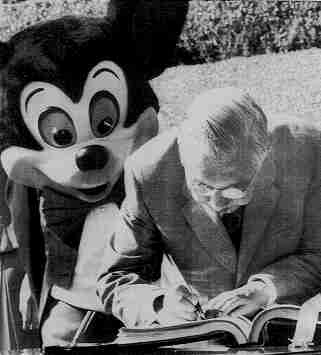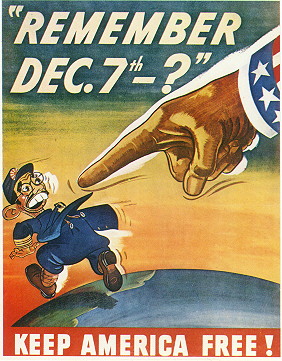Hirohito
Emperor Hirohito Michi-no-miya (Showa-tenno)
 The Japanese refer to him posthumously as Emperor Showa, but everybody else still calls him Hirohito. We saw him as a quaint, little old man who ate bacon and eggs every morning. He wore a Mickey Mouse watch. We knew he was royalty, but we assumed it was only the irrelevant figurehead variety.
The Japanese refer to him posthumously as Emperor Showa, but everybody else still calls him Hirohito. We saw him as a quaint, little old man who ate bacon and eggs every morning. He wore a Mickey Mouse watch. We knew he was royalty, but we assumed it was only the irrelevant figurehead variety.
It is easy to forget that until 1945, the Emperor of Japan was officially considered to be divine -- the Son of Heaven. The royal family were direct descendants of the sun god. The Japanese took this whole thing very seriously. Accordingly, it was forbidden for his subjects to look at his face, address him by name, or speak to him from a greater height.
When a politician suggested in 1935 that the Emperor was just an ordinary human being whose power derived from the will of the people, it caused a furor. The politican was forced to resign, his books were banned, and an attempt was made on his life.
When it comes to Emperor Hirohito we seem to have a bad memory, particularly where it involves his responsibility for the war in the Pacific. Hirohito was an unindicted war criminal, plain and simple. No, he wasn't a dictator. He did not singlehandedly orchestrate the Japanese war effort. But he was there, every step of the way, receiving regular reports and pushing his generals for victory.
In 1931 Japan invaded Manchuria and unleashed holy terror. There they implemented the "Three Alls" policy: kill all, loot all, burn all. When Nanking fell, Japanese forces launched a merciless campaign against its citizenry, raping and killing by the thousands. Later they set up a chemical weapons unit, which developed cyanide bombs and tested them on civilian prisoners. They also set up a biowarfare unit, which exposed prisoners to typhoid, cholera, plague, and anthrax and then vivisected them without anesthesia to determine their effects.
 Hirohito was fully aware of these developments, but never lifted a finger to discourage any of it. Instead of recognizing the inevitability of surrender in early 1945, he signed off on the creation of Kamikaze pilots, who flew suicide missions in the Emperor's name.
Hirohito was fully aware of these developments, but never lifted a finger to discourage any of it. Instead of recognizing the inevitability of surrender in early 1945, he signed off on the creation of Kamikaze pilots, who flew suicide missions in the Emperor's name.
After the war, MacArthur decided it was necessary for the recovery of the Japanese nation to maintain continuity in the form of the Emperor. So everybody involved in the War Crimes trials scrupulously avoided any mention of Hirohito. Even the defendants played along, despite the fact that it would have helped their cases to claim that they were following orders. When Tojo told his lawyer that "the subjects of Japan can never say or do anything against His Majesty's will," the prosecutors convinced him not to say that on the stand.
Hirohito fooled us into believing he was harmless and blameless, but only because we told him to.
Timeline
| 29 Apr 1901 |
Hirohito born in Tokyo. |
| 30 Jul 1912 |
Hirohito granted the title of Prince Regent. |
| 1921 |
Prince Regent Hirohito becomes the first member of Japanese royalty to step foot outside his country when he takes a six-month trip to Europe. |
| 27 Dec 1923 |
Failed assassination attempt on Prince Regent Hirohito of Japan. Daisuke Nanba shot at the imperial limousine but missed the prince. (Toranomon Incident) |
| 25 Dec 1926 |
Hirohito ascends the throne, becoming Emperor of Japan. |
| 10 Nov 1928 |
Emperor Hirohito of Japan's formal coronation. |
| Mar 1931 |
Aborted coup attempt. |
| 8 Jan 1932 |
Failed assassination attempt on Emperor Hirohito of Japan. (Sakuradamon Incident) |
| 15 May 1932 |
Failed coup attempt. |
| 1935 |
Controversy arises over the constitutional status of the emperor. (TENNO KIKAN SETSU) |
| 26 Feb 1936 |
Failed coup d'etat attempt against Emperor Hirohito of Japan. 1,400 troops participated. |
| Mar 1937 |
Failed coup attempt. |
| 13 Dec 1937 |
Rape of Nanking begins. |
| 1 Apr 1941 |
National school system (Kokumin Gakko) rededicated to training "loyal subjects of the emperor." All children were taught to be dedicated subjects of the emperor, and to fight the war for the emperor, based on the Imperial Way. Third-grade textbooks declare: "There are many countries around the world, but Japan is the only country that is destined to prosper forever under our emperor, who is divine." |
| 6 Aug 1945 |
Hiroshima. |
| 9 Aug 1945 |
Nagasaki. |
| 15 Aug 1945 |
Failed coup attempt. |
| 2 Sep 1945 |
Foreign Minister Mamoru Shigemitsu signs the instrument of surrender aboard the USS Missouri. |
| 27 Sep 1945 |
Emperor Hirohito of Japan meets with SCAP Douglas MacArthur. |
| 1 Jan 1946 |
Hirohito publicly renounces his divinity. |
| 1946 |
Hirohito begins a series of goodwill tours of his country. |
| 1946 |
Commencement of the International Military Tribunal for the Far East (1946-48; WAR CRIMES TRIALS). |
| 1946 |
Food May Day: 300,000 demonstrate outside the Imperial Palace. (SHOKURYO MEDE) |
| 1952 |
SAN FRANCISCO PEACE TREATY goes into effect; Japan regains sovereignty. |
| ??? 1970 |
Hirohito meets Richard M. Nixon in Anchorage, Alaska. |
| 2 Oct 1975 |
Emperor Hirohito of Japan visits President Gerald Ford at the White House. |
| 1975 |
Emperor Hirohito of Japan visits Disneyland. |
| 1984 |
Emperor Hirohito of Japan expresses regret over his country's "unfortunate past" with Korea, during a visit with Korean President Chon Du-hwan. ("It is indeed regrettable that there was an unfortunate past between us for a period in this century and I believe that it should not be repeated again.") |
| 7 Jan 1989 |
Emperor Hirohito of Japan dead at age 87 from complications after surgery. |
| 24 Feb 1989 |
Hirohito's state funeral |
|
Hirohito's remains placed in the Musashino Imperial Mausoleum in Hachioji. The emperor's Mickey Mouse watch accompanied him to his final resting place. |
| Dec 2000 |
A mock trial convicts Hirohito of crimes against humanity, specifically his responsibility for the "Comfort Women" system of sexual slavery during the Japanese occupation of Korea. |
|
 The Japanese refer to him posthumously as Emperor Showa, but everybody else still calls him Hirohito. We saw him as a quaint, little old man who ate bacon and eggs every morning. He wore a
The Japanese refer to him posthumously as Emperor Showa, but everybody else still calls him Hirohito. We saw him as a quaint, little old man who ate bacon and eggs every morning. He wore a  Hirohito was fully aware of these developments, but never lifted a finger to discourage any of it. Instead of recognizing the inevitability of surrender in early 1945, he signed off on the creation of
Hirohito was fully aware of these developments, but never lifted a finger to discourage any of it. Instead of recognizing the inevitability of surrender in early 1945, he signed off on the creation of